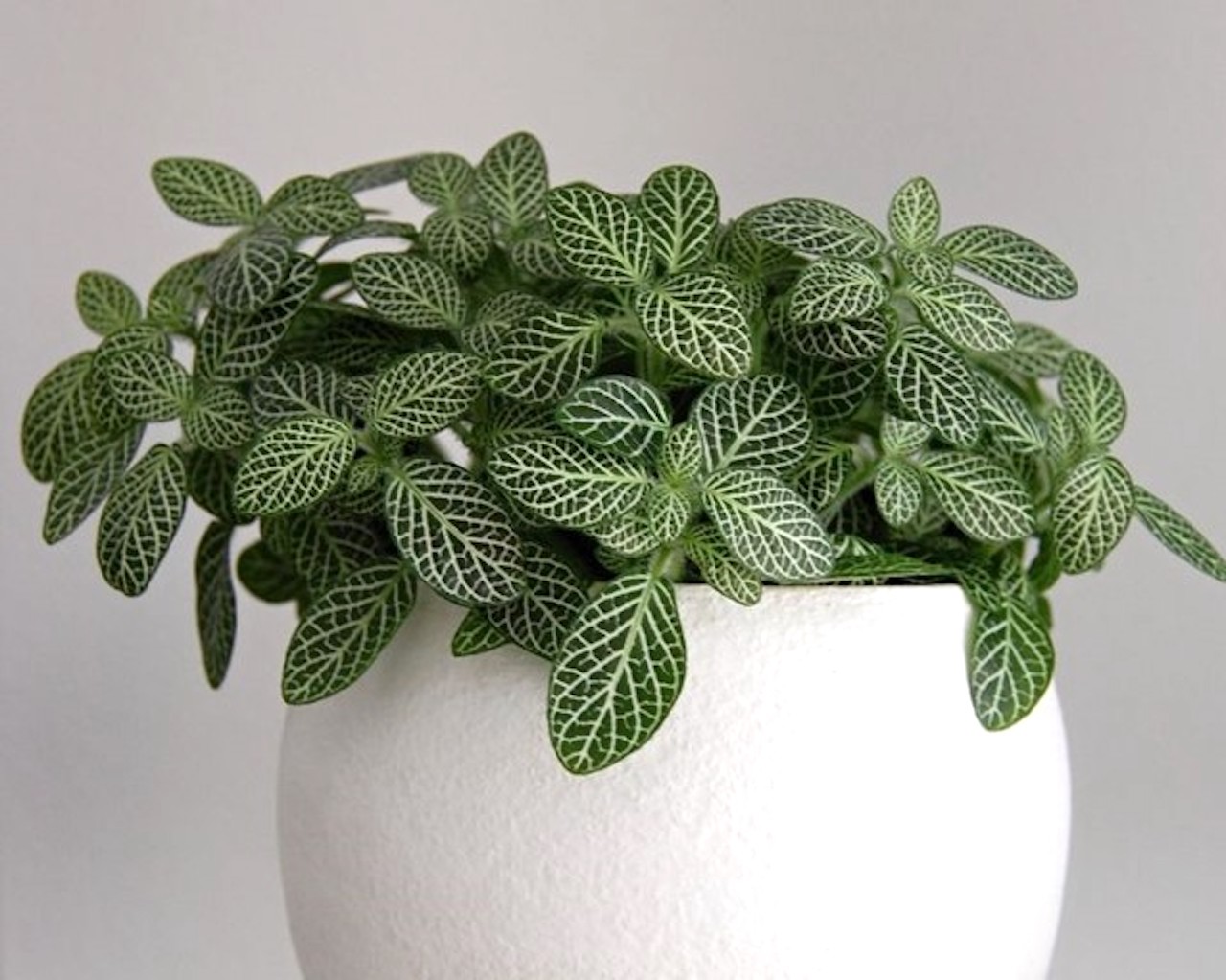Fittonia is a charming houseplant, but suffers severely from dehydration in the winter months. Photo: yates.com.au
Winter is hard on the popular houseplant known as the nerve plant, mosaic plant or simply fittonia (Fittonia albivenis, formerly F. verschaffeltii and F. argyroneura). This charming little creeping plant with leaves beautifully highlighted by contrasting white, pink or red veins copes badly with dry air … and our homes can barely keep the air humid enough for humans, let alone fittonias! Think 70 to 90% humidity for it to be really happy, yet in most homes, maintaining 40% relative humidity is a struggle during the heating season. That’s because as you bring cold outside air indoors and heat it, its relative humidity plummets and thin-leaved plants like fittonia suffer.

In dry air, the leaves simply can’t absorb water fast enough to keep up with the moisture lost to transpiration, so they wither like lettuce in the sun. And the plant needs regular watering as well, as it quickly pumps the potting mix dry by absorbing more water via its roots, struggling to compensate for water loss from its leaves. If you water well, it will generally recuperate … then wilt again a few days later. It’s hard to keep up! And then one day, you find it wilted yet again and try to revive it, but it no longer reacts. R.I.P.
Winters are tough for this humidity lover!
What Can You Do to Help?

Well, first, do keep up with the watering. You’ll probably need to water exposed plants at least twice a week during the heating season. Whenever the soil seems just a bit dry, it’s time to drench the root ball with tepid water.
But that only solves part of the problem. The air is still dry and leaves will still wilt a bit and older ones will drop off. So, what can you do about that?

Well, forget about spraying the leaves with tepid water (when you find a website spraying houseplants with water to improve relative humidity, you know they have no idea what they’re talking about!) Misting does no good whatsoever. (Read Horticultural Myth: Misting Your Houseplants to find out why.)
You could try a humidity tray and that will help a bit, or putting your humidifier on Maximum and running it 24 hours a day, but you’ll still have to water like crazy.

The best thing is to grow your fittonia under glass, at least for the winter, creating a greenhouse environment bathed in humidity.
For example, you could plant it a terrarium or just place it inside one. Or even just cover it in with a transparent pastry dome or any inverted clear plastic or glass container. The relative humidity will soar! I put mine inside a sealed plastic bag for the winter: it may not look elegant, but it thrives there.

Under glass, the plant will need very little watering since it will no longer lose much water through transpiration. If you moisten it well, but not to excess, before you cover it, a fittonia in a closed terrarium may well be able to go a month or more without watering.
Try growing fittonia under glass and you’ll see: you’ll get an instant green thumb!
And here’s more about this intriguing plant:
From Jungle to Living Room

In the wild, the fittonia is a jungle plant, a groundcover from the Amazon Basin of South America. There it creeps along the ground, rooting at the nodes. It has opposite, oval dark green leaves with contrasting white veins and would make a great carpeting plant if you lived in a tropical rainforest.
In our homes, the fittonia is best used for tabletops, miniature gardens and terrariums. It also looks great in hanging baskets, but will only thrive that way long term where the air is humid.

It also blooms fairly readily, but the upright green conelike spikes bearing tiny pale yellow flowers are not very striking and many people simply clip them off.
Medium to fairly low light is fine. Full, blazing summer sun isn’t, so keep it back from a hot window at that season.
Keep it warm at all times. Room temperature or above (65 to 85?F/18 to 30?C) is perfect, but it will take down to 50?F (10?C) if necessary.
For even growth, fertilize it lightly but regularly spring through fall with whatever fertilizer you have on hand.
It grows quite rapidly for such a small plant, but can become bare in the middle over time as it expands outwards, so don’t hesitate to pinch and prune to force it to fill in.
You can repot into regular potting soil if you want, but I find it ages badly and it’s better to start new plants from stem cuttings (they root readily under glass) than to try to recuperate an aging plant.
A Rainbow of Colors?

Well, not quite, but considering the original color was just green with white veins (the meaning of albivenis), there are a surprising number of cultivars with veins of different colors: white, pink, red, purple, salmon, etc. while the leaf blade itself can range from pale green to dark, almost purple shades. Often, the coloration extends beyond the veins to cover a good part of the leaf. Also, there are varieties marbled with irregular variegation and others with smaller leaves than normal, some with fringed leaf margins, etc.
Locally, I only seem to find them in mixed batches with no labels, so it’s hard to tell which cultivar is which. If you’re looking for a specific variety, try a terrarium specialist. They often offer a good range of cultivars, as the fittonia is such a great terrarium plant.
______________________
The fittonia: pretty and intriguing, but keep that humidity up!

Pingback: Polka Dot Plant: The August 2021 Houseplant of the Month – Laidback Gardener
In mild climates, these can make nice small scale ground cover for shady spots. They just don’t take traffic well.